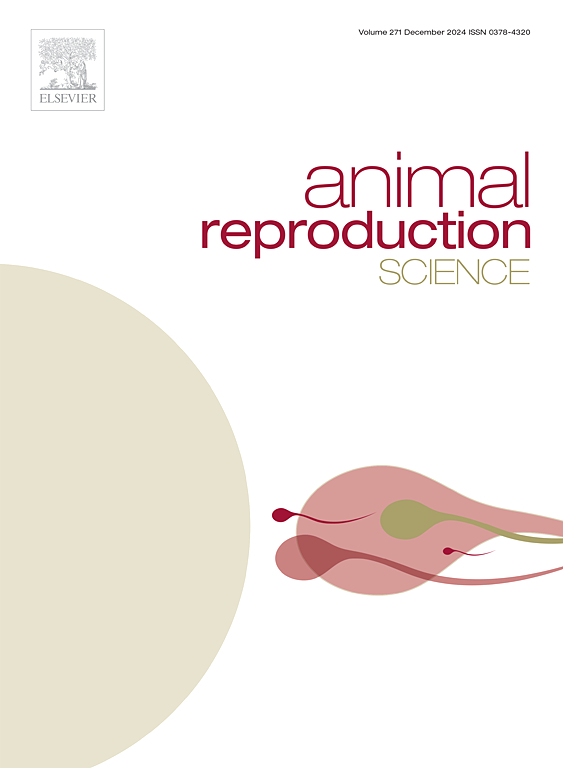Immunological defense mechanisms of ejaculates and the spread of viral infectious diseases through pig semen
IF 2.2
2区 农林科学
Q1 AGRICULTURE, DAIRY & ANIMAL SCIENCE
引用次数: 0
Abstract
This review focuses on the mechanisms of immune tolerance and antimicrobial defense in the male genital tract of the pig. Sperm cells are foreign to the immune system and, therefore, they must be protected from the immune system. The blood-testis-barrier is mediated by a physical barrier between adjacent Sertoli cells, several cell types within the testis, and interactions between immunomodulatory molecules. The blood-epididymal-barrier is composed of a physical barrier that is lined with principal cells having a network of junctional complexes in their apical lateral membrane and completed by specific transporters. The seminal plasma (SP) contains many signaling agents involved in establishing a state of immune tolerance in the female genital tract, which is essential for successful fertilization. Specific SP-proteins, however, also have pro-inflammatory capacities contributing to transient uterine inflammation, supporting the removal of foreign cells, possible pathogens, and excessive spermatozoa. While many different proteins and other substances present in semen can damage sperm cells, they may also protect them against viral infections. A delicate balance of these substances, therefore, needs to be maintained. Related to this, recent studies have shown the importance of extracellular vesicles (EVs), as they contain these substances and convey immune signals. Yet, viruses may use EVs to interact with the male genital tract and circumvent immune responses. For this reason, further research needs to explore the role of EVs in the male reproductive tract, as it might contribute to elucidating the pathogenesis of viral infections that might be transmitted via semen and to developing better vaccines.
射精的免疫防御机制和病毒性传染病通过猪精液的传播。
这篇综述的重点是猪雄性生殖道的免疫耐受和抗菌防御机制。精细胞对于免疫系统来说是外来物,因此必须受到免疫系统的保护。血液-睾丸屏障是由相邻的 Sertoli 细胞之间的物理屏障、睾丸内的几种细胞类型以及免疫调节分子之间的相互作用介导的。血液-睾丸屏障由一个物理屏障组成,其内衬是在顶端侧膜上具有连接复合体网络的主细胞,并由特定的转运体完成。精浆(SP)中含有许多信号物质,参与在女性生殖道中建立免疫耐受状态,这对成功受精至关重要。然而,特定的精浆蛋白也具有促炎能力,可引起短暂的子宫炎症,有助于清除外来细胞、可能的病原体和过多的精子。虽然精液中的许多不同蛋白质和其他物质会损害精子细胞,但它们也能保护精子细胞免受病毒感染。因此,需要保持这些物质之间的微妙平衡。与此相关,最近的研究显示了细胞外囊泡(EVs)的重要性,因为它们含有这些物质并能传递免疫信号。然而,病毒可能会利用细胞外囊泡与男性生殖道相互作用,规避免疫反应。因此,需要进一步研究EVs在男性生殖道中的作用,因为这可能有助于阐明可能通过精液传播的病毒感染的发病机制,并有助于开发更好的疫苗。
本文章由计算机程序翻译,如有差异,请以英文原文为准。
求助全文
约1分钟内获得全文
求助全文
来源期刊

Animal Reproduction Science
农林科学-奶制品与动物科学
CiteScore
4.50
自引率
9.10%
发文量
136
审稿时长
54 days
期刊介绍:
Animal Reproduction Science publishes results from studies relating to reproduction and fertility in animals. This includes both fundamental research and applied studies, including management practices that increase our understanding of the biology and manipulation of reproduction. Manuscripts should go into depth in the mechanisms involved in the research reported, rather than a give a mere description of findings. The focus is on animals that are useful to humans including food- and fibre-producing; companion/recreational; captive; and endangered species including zoo animals, but excluding laboratory animals unless the results of the study provide new information that impacts the basic understanding of the biology or manipulation of reproduction.
The journal''s scope includes the study of reproductive physiology and endocrinology, reproductive cycles, natural and artificial control of reproduction, preservation and use of gametes and embryos, pregnancy and parturition, infertility and sterility, diagnostic and therapeutic techniques.
The Editorial Board of Animal Reproduction Science has decided not to publish papers in which there is an exclusive examination of the in vitro development of oocytes and embryos; however, there will be consideration of papers that include in vitro studies where the source of the oocytes and/or development of the embryos beyond the blastocyst stage is part of the experimental design.
 求助内容:
求助内容: 应助结果提醒方式:
应助结果提醒方式:


